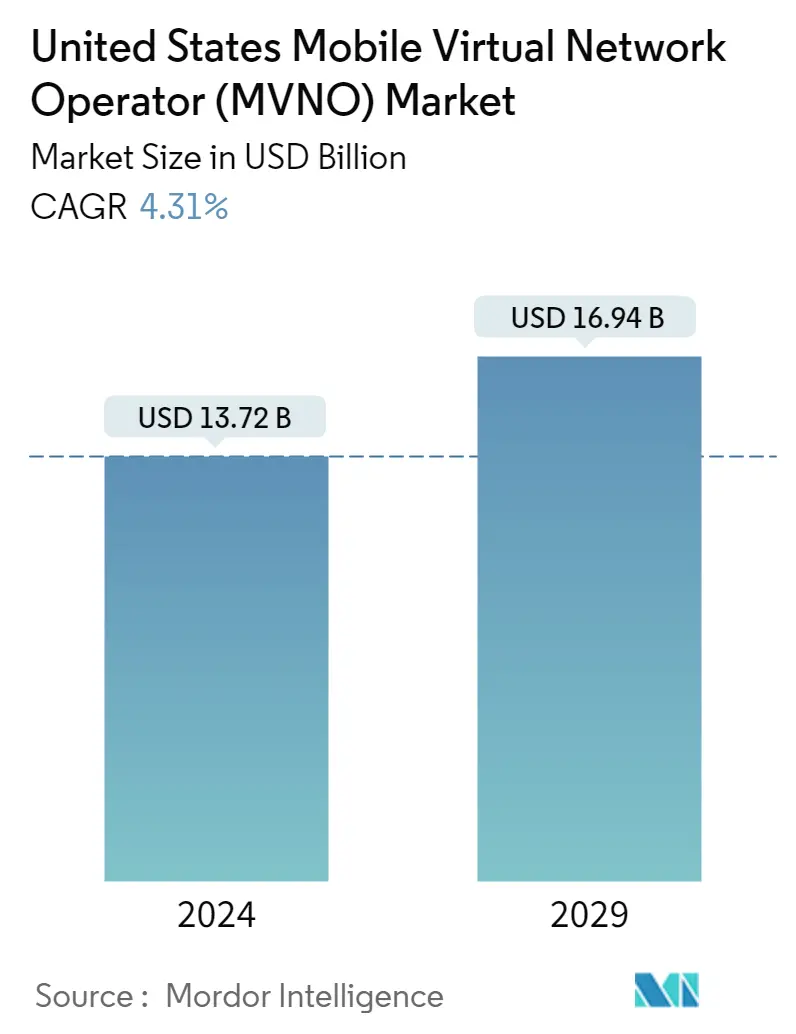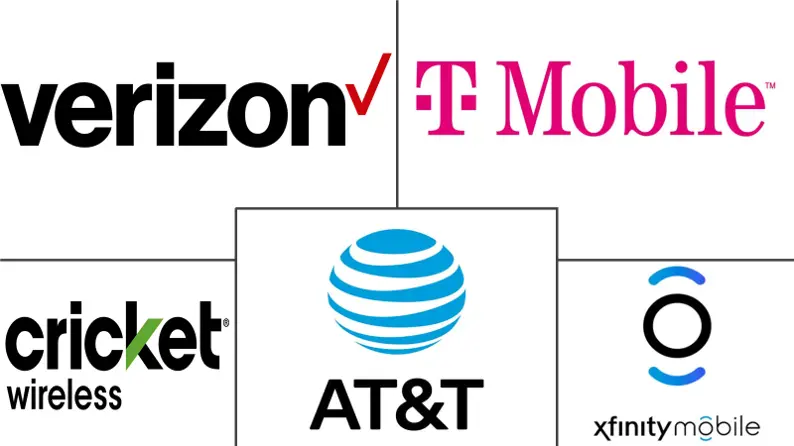Market Size of United States Mobile Virtual Network Operator (MVNO) Industry

| Study Period | 2019 - 2029 |
| Base Year For Estimation | 2023 |
| Market Size (2024) | USD 13.72 Billion |
| Market Size (2029) | USD 16.94 Billion |
| CAGR (2024 - 2029) | 4.31 % |
| Market Concentration | Medium |
Major Players
*Disclaimer: Major Players sorted in no particular order |
US Mobile Virtual Network Operators (MVNO) Market Analysis
The United States Mobile Virtual Network Operator Market size is estimated at USD 13.72 billion in 2024, and is expected to reach USD 16.94 billion by 2029, growing at a CAGR of 4.31% during the forecast period (2024-2029).
The mobile virtual network operator (MVNO) market in the United States is considered mature and developed. The MVNOs first started operation in the United States in 2011. Since then, the MVNO market has had prolonged growth compared to the increase in the number of mobile subscribers. The United States has four major carriers, which provide network infrastructure to 139 MVNOs who serve their 36 million active subscribers as of April 2019, as reported by GSMA. MVNOs flourished in the United States due to the Lifeline program run by FCC in the United States. The major States in the United States have partnered with a few MVNOs to provide mobile and broadband services at a very subsidized rate.
- Mobile virtual network operators (MVNOs) are facing a wave of change as evolving demand and competition, and technology advancements bring the latest opportunities and challenges for MVNOs and their mobile network operators (MNO) hosts. The US mobile market is moving towards saturation and a crossed 80% penetration rate during 2019 with big companies such as T-Mobile, Verizon, and AT&Tcommanding significant share of the country's user base. In the US, MVNOs are increasingly becoming a means of bringing additional segments into the subscriber base on to the host operator network via focusing on specific value propositions for niche target segments of customers. MVNOs are one of the faster, cheaper entry approaches compared to building a network with the comparatively cost-effective service offering from MVNOs the services are popular amongst the users of used and refurbished handset users in the country.
- As the wireless telephone subscription reaches the level-off point, the country's growing propensity towards data usage fuels the growth of MVNOs where big four MNOs in the country are pushing to gain from the MVNOs user base. According to ACSI, customer satisfaction with full-service MVNOs was higher than that of MNOs during 2019, which stood at 77 compared to MNO's 73. Cricket Wireless, Metro by T-Mobile, Virgin, and Boost were amongst the top with Cricket Wireless topping the category with 79 points and over 10 million subscribers. The company achieved this feat by offering the best in range wireless plans among full-service MVNOs. BYODs are another driving factor pushing the market growth in the country and enterprise-scale adoption and an entry point for MVNOs in the lucrative postpaid market.
- The MNVO market is also witnessing mergers in the United States. For instance, in July 2020, DISH announced today that it had completed its USD 1.4 billion acquisition of Boost Mobile. With this acquisition, DISH officially enters the retail wireless market, serving more than nine million customers. Boost was previously operated and owned by Sprint. Following the Sprint and T-Mobile merger, in April 2020, DISH has acquired Boost Mobile. In July 2019, DISH announced a series of agreements it reached with the DOJ and FCC as part of the merger between Sprint and T-Mobile. DISH network got access to the T-Mobile network for seven years, including the ability to serve DISH customers between DISH's forthcoming standalone 5G network and T-Mobile's nationwide network first-of-its-kind in the United States. DISH continued to make progress on its 5G network deployment and announced Fujitsu's selection for radio units.
- To ensure business continuity due to the COVID-19 outbreak, business organizations, especially in profoundly affected countries, allow their employees to work from home (WFH). The increase in people working from home has led to the rise in demand for downloading, online video viewing, and communication through video conferencing, leading to increased network traffic and data usage. T-Mobile has multiplied its low-band 4G capacity by up to six times to support working and schooling from home. This will continue until the pandemic ends. Thus, MVNOs, which are using T-Mobile's and other similar networks, are expected to play a crucial role in supporting the US's networking infrastructure. In March 2020, Cricket Wireless launched a new USD 15 plan with 2GB data and unlimited talks and texts without any activation given COVID-19 impact for a limited period that will expire in May 2020.
US Mobile Virtual Network Operators (MVNO) Industry Segmentation
Mobile Virtual Network Operators (MVNO's) are wireless service providers that do not own the wireless network infrastructure but instead buy network capacity from existing MNOs to deliver services to their users. Operational Models such as Reseller, Service Operator, Full MVNO, and Other modes are considered under the scope. The study also offers an assessment of the impact of COVID-19 on the industry.
| By Operating Model | |
| Reseller | |
| Service Operator | |
| Full MVNO | |
| Other Operational Models |
| By Subscriber | |
| Business | |
| Consumer |
United States Mobile Virtual Network Operator (MVNO) Market Size Summary
The United States Mobile Virtual Network Operator (MVNO) market is characterized by its maturity and development, having commenced operations in 2011. The market has experienced sustained growth, outpacing the increase in mobile subscribers, and is supported by four major carriers providing infrastructure to numerous MVNOs. These operators have capitalized on programs like the FCC's Lifeline to offer subsidized mobile and broadband services. As the US mobile market approaches saturation, MVNOs are increasingly focusing on niche segments, leveraging cost-effective service offerings to attract users of refurbished handsets. The demand for data-driven services, coupled with the penetration of advanced technologies like 4G and 5G, is propelling MVNOs to expand their subscriber base and enhance their value propositions.
The MVNO landscape in the United States is witnessing significant transformations due to technological advancements and strategic mergers. The acquisition of Boost Mobile by DISH Network exemplifies the ongoing consolidation in the sector, enabling DISH to enter the retail wireless market and expand its customer base. The rise in connected devices and the growing importance of IoT and machine-to-machine communication are further driving the demand for efficient network solutions, where MVNOs play a crucial role. The reseller model is gaining traction, offering MVNOs a low-cost entry point with the potential for substantial growth, especially with the ongoing 5G transformation. Major players like Verizon, AT&T, and T-Mobile continue to dominate the market, while MVNOs innovate to maintain competitive advantage amidst price pressures and evolving consumer demands.
United States Mobile Virtual Network Operator (MVNO) Market Size - Table of Contents
-
1. MARKET INSIGHTS
-
1.1 Market Overview
-
1.2 Industry Value Chain Analysis
-
1.3 Industry Attractiveness - Porter's Five Forces Analysis
-
1.3.1 Bargaining Power of Suppliers
-
1.3.2 Bargaining Power of Buyers
-
1.3.3 Threat of New Entrants
-
1.3.4 Threat of Substitute Products
-
1.3.5 Intensity of Competitive Rivalry
-
-
1.4 Technology Snapshot
-
1.5 COVID-19 impact on the MVNO market
-
-
2. MARKET SEGMENTATION
-
2.1 By Operating Model
-
2.1.1 Reseller
-
2.1.2 Service Operator
-
2.1.3 Full MVNO
-
2.1.4 Other Operational Models
-
-
2.2 By Subscriber
-
2.2.1 Business
-
2.2.2 Consumer
-
-
United States Mobile Virtual Network Operator (MVNO) Market Size FAQs
How big is the United States Mobile Virtual Network Operator (MVNO) Market?
The United States Mobile Virtual Network Operator (MVNO) Market size is expected to reach USD 13.72 billion in 2024 and grow at a CAGR of 4.31% to reach USD 16.94 billion by 2029.
What is the current United States Mobile Virtual Network Operator (MVNO) Market size?
In 2024, the United States Mobile Virtual Network Operator (MVNO) Market size is expected to reach USD 13.72 billion.

